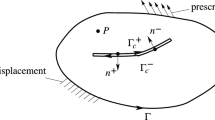Abstract
An SGBEM-FEM alternating method had been proposed by Nikishkov, Park and Atluri for the analysis of three-dimensional planar and non-planar cracks and their growth. The proposed method is an effective method for fatigue or stress corrosion crack growth simulation. During crack growth simulation, however, an oscillation phenomenon is observed in crack advance or stress intensity factor distribution. If oscillating amplitude in SIF or crack advance does not decrease during next increment steps, the crack growth simulation fails. In this paper several methods are examined to remove the oscillation phenomenon. As a result, it is found that smoothing in stress intensity factor distribution or in crack front geometry can remove or weaken the oscillation phenomenon. Using the smoothing techniques, stress corrosion crack growth simulation is performed for a semi-elliptical surface crack and a through-thickness crack embedded in a plate. Crack front shape and stress intensity factor distribution are obtained after each increment during the crack growth. And the depth and length of a crack are obtained as a function of time. It is noted that the SGBEM-FEM alternating method is a very effective method for SCC growth simulation for a surface crack and a through-thickness crack.
Similar content being viewed by others
References
S. N. Atluri, Structural integrity and durability, Tech Science Press, Forsyth, GA, 1997.
T. Nishioka and S. N. Atluri, Analytical solution for embedded elliptical cracks and finite element — alternating method for elliptical surface cracks, subjected to arbitrary loadings, Eng. Fract. Mech., 17 (1983) 247–268.
K. Vijaykumar and S. N. Atluri, An embedded elliptical crack, in an infinite solid, subject to arbitrary crack-face tractions, J. Appl. Mech., 103(1) (1981) 88–96.
Z. D. Han and S. N. Atluri, SGBEM (for cracked local subdomain)-FEM (for uncracked global structure) alternating method for analyzing 3D surface cracks and their fatigue-growth, Computer Modeling in Engineering & Sciences, 3(6) (2002) 699–716.
G. P. Nikishkov, J. H. Park and S. N. Atluri, SGBEM-FEM alternating method for analyzing 3D non-planar cracks and their growth in structural components, Comp. Modeling in Engng & Sci., 2(3) (2001) 401–422.
M. Bonnet, G. Maier and C. Polizzotto, Symmetric Galerkin boundary element methods, Appl. Mech. Rev., 51 (1998) 669–704.
S. Li and M.E. Mear, Singularity-reduced integral equations for displacement discontinuities in three-dimensional linear elastic media, Int. J. Fract., 93 (1998) 87–114.
J. H. Park, M. W. Kim and G. P. Nikishkov, SGBEM-FEM alternating method for simulating 3D through-thickness crack growth, Computer Modeling in Engineering & Sciences, 68 (2010) 269–296.
S. Li, M. E. Mear and L. **ao, Symmetric weak-form integral equation method for three-dimensional fracture analysis, Comput. Meth. Appl. Mech. Engng, 151 (1998) 435–459.
A. Frangi, G. Novati, R. Springhetti and M. Rovizzi, Fracture mechanics in 3D by the symmetric Galerkin boundary element method, VIII Conf. on Numerical Methods in Continuum Mechanics, 19–24 Sept. 2000, Liptovsky Jan, Slovak Republic, 2000.
G. P. Nikishkov and S. N. Atluri, Combining SGBEM and FEM for modelling 3D cracks. In: Engineering computational technology (Ed. B. H. V. Top** and Z. Bittnar), Saxe-Coburg (2002) 167–192.
K. Saito and J. Kuniya, Mechanochemical model to predict stress corrosion crack growth of stainless steel in high temperature water. Corrosion Science, 43 (2001) 1751–1766.
D. O. Harris and D. Dedhia, WinPRAISE 98: PRAISE code in windows, ETM TR-98-4-1, 1988.
Q. J. Peng, J. Kwon and T. Shoji, Development of a fundamental crack tip strain rate equation and its application to quantitative prediction of stress corrosion cracking of stainless steels in high temperature oxygenated water, Journal of Nuclear Materials, 324 (2004) 52–61.
T. L. Anderson, Fracture mechanics, 3rd ed., CRC Press, 2005.
J. H. Park and G. P. Nikishkov, Examination and improvement of accuracy of three-dimensional elastic solutions obtained using finite element alternating method, Transactions of the KSME A, 34 (2010, 629–635 (in Korean).
Author information
Authors and Affiliations
Corresponding author
Additional information
This paper was recommended for publication in revised form by Associate Editor Chongdu Cho
Jai Hak Park received his M.S. and Ph.D. in Mechanical Engineering from KAIST. He is currently a professor at Chungbuk National University. His research interests are in the area of fracture mechanics, computational mechanics and probabilistic assessment of structure.
Gennadiy Nikishkov received his Ph.D. and D.Sc. in Computational Mechanics from the Moscow Engineering Physics Institute. He held a Professor position at the Moscow Engineering Physics Institute. Dr. Nikishkov is currently a Professor at the University of Aizu, Japan. His research interests include computational modeling, high performance computing, visualization and computer graphics.
Rights and permissions
About this article
Cite this article
Park, J.H., Nikishkov, G.P. Growth simulation for 3D surface and through-thickness cracks using SGBEM-FEM alternating method. J Mech Sci Technol 25, 2335–2344 (2011). https://doi.org/10.1007/s12206-011-0528-3
Received:
Revised:
Accepted:
Published:
Issue Date:
DOI: https://doi.org/10.1007/s12206-011-0528-3




